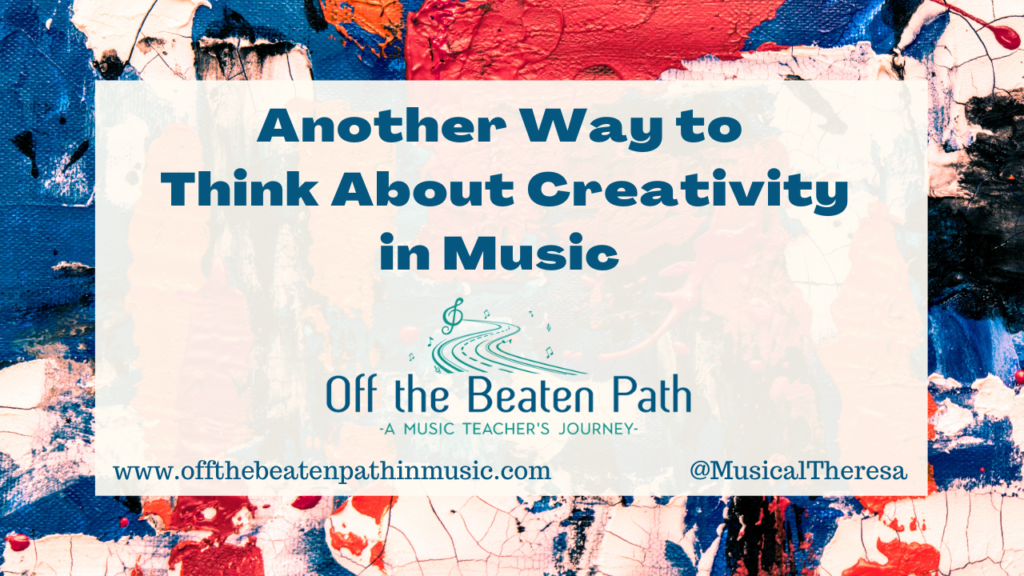Another Way to Think About Creativity in Music
For many music teachers, the creativity standards are the most elusive and sometimes challenging to incorporate. When the National Core Arts Standards were released in 2014, there was a noticeable change in the format and language included in the standards. What were nine simple statements turned into a multi-page document with numerous subsections. The difference is, these standards focus on the artistic process and music literacy, whereas the 1994 standards focused on specific skills and knowledge. I believe this was a wonderful revision and a step in the right direction for music education. If we want our students to truly be musical, taking part in the artistic process is necessary. And that starts with musical creativity.

So often when thinking about creativity, we assume it starts with a blank slate. But the fact is, when teaching someone to be creative, this is often the least effective method. A better idea is to think about creativity as a process, guiding students through it on more than one occasion.
In Pass the Baton, we discuss a similar process as described by John Spencer and A.J. Juliani in their book, Empower: What Happens When Students Own Their Learning. Spencer and Juliani describe a seven-step process through which students move from consumers to creators. They explain that consuming is necessary for creativity, and through that consumption, one becomes inspired to create. (To learn more about this consumer to creator process, check out this video: Why Consuming is Necessary for Creating.)
The Three-Step Process
As music educators, we excel in the stages of critical consumption, but too often we stop before any real creativity takes place. I believe we can look at creativity in three simple steps that make the process accessible and meaningful to students. First you copy, then iterate, then create.
Copy
The first step is for students to copy, or re-create, an artistic work. If we think about it, this is the same way we learn language! Children copy or mimic the words they hear spoken by others, and in time, understand their meaning. The same is true in music. We can start by having students copy what they hear, echoing a model. The same is true for written music, we can have students simply copy a written composition, such as a well-known melody or line from the method book. As they copy, students learn about the sounds and the symbols associated with the musical language.
Iterate
The next step after copying is to iterate. In this step, students take what they’ve copied and make changes, making it more personal. Students can use the knowledge they gained from copying to experiment and try new things. You might call this a remix: taking an existing artistic work and putting our own personal spin on it.

Create
Finally, we can encourage students to create. They can use the tools they learned when copying and iterating to make something that is unique, and truly their own. In this case, it still doesn’t have to be created from a blank space. It’s okay to provide students with guidelines or even requirements. For example, you may require that students include specific pitches or musical elements in their creation. Or you may provide a minimum length or level of difficulty.
What Does it Look Like?
As with anything else, start small! Your first creativity project doesn’t have to be a huge endeavor. Here are a few ideas to consider:
- Improvisation – Start by having students echo (copy) you playing or singing simple patterns. Once they are comfortable, students can make small changes to the patterns they echo (iterate). Finally, students can create their own patterns.
- Composition (written) – Have students copy a familiar melody or line from the method book. This can work by hand-writing or using digital music notation programs like Noteflight Learn or Flat for Education. Next, have students create a variation based on that melody, either by changing pitches, rhythms, or other stylistic elements. Finally, students can create their own melody from scratch.
- Movement – Students should start by copying your motions to accompany a song. Then students can use your motions as a basis and make small iterations. The final step is for students to create their own motions.
Provide the Floor, Not the Ceiling
When assigning creative work, it’s important to provide students with the floor but not the ceiling. Share your expectations, share any minimum requirements, but encourage students to move beyond that as their experience and creativity allow them. Remember that, as with most new things, students will develop along their own timeline.
Some students will feel comfortable moving to the “create” stage quickly, while others will need more time to copy and iterate. This is okay! Provide guidance and frequent reminders that there are no right or wrong answers. The music room should be a safe space, and anyone should feel comfortable taking a risk when they are ready.
Want to read more about creativity?
You can never have too much creativity in the music classroom! Here are a few resources to get the creative juices flowing:


